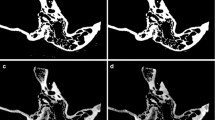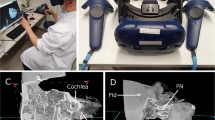Abstract
Purpose
Automatic scoring of resident performance on a virtual mastoidectomy simulation system is needed to achieve consistent and efficient evaluations. By not requiring immediate expert intervention, the system provides a completely objective assessment of performance as well as a self-driven user assessment mechanism.
Methods
An iconic temporal bone with surgically important regions defined into a fully partitioned segmented dataset was created. Comparisons between expert-drilled bones and student-drilled bones were computed based on gradations with both Euclidean and Earth Mover’s Distance. Using the features derived from these comparisons, a decision tree was constructed. This decision tree was used to determine scores of resident surgical performance. The algorithm was applied on multiple expert comparison bones and the scores averaged to provide reliability metric.
Results
The reliability metrics for the multi-grade scoring system are better in some cases than previously reported binary classification metrics. The two scoring methods given provide a trade-off between accuracy and speed.
Conclusions
Comparison of virtually drilled bones with expert examples on a voxel level provides sufficient information to score them and provide several specific quality metrics. By merging scores from different expert examples, two related metrics were developed; one is slightly faster and less accurate, while a second is more accurate but takes more processing time.
Similar content being viewed by others
References
Ahmidi N, Hager GD, Ishii L, Fichtinger G, Gallia GL, Ishii M (2010) Surgical task and skill classification from eye tracking and tool motion in minimally invasive surgery. In: Jiang T, Navab N, Pluim JP, Viergever MA (eds) MICCAI. Springer, Berlin, pp 295–302
Bryan J, Stredney D, Wiet G, Sessanna D (2001) Virtual temporal bone dissection: a case study. In: IEEE visualization, pp 497–500
Butler NN, Wiet GJ (2007) Reliability of the Welling scale (WS1) for rating temporal bone dissection performance. Laryngoscope 117(10): 1803–1808. doi:10.1097/MLG.0b013e31811edd7a
Cleveland WS, McGill R (1984) The many faces of a scatterplot. J Am Stat Assoc 79(388): 807–822
Cotin S, Stylopoulos N, Ottensmeyer MP, Neumann PF, Rattner D, Dawson S (2002) Metrics for laparoscopic skills trainers: the weakest link! In: MICCAI, pp 35–43
Cristancho SM, Hodgson AJ, Panton ONM, Meneghetti A, Warnock G, Qayumi K (2009) Intraoperative monitoring of laparoscopic skill development based on quantitative measures. Surg endosc 23(10): 90–2181. doi:10.1007/s00464-008-0246-9
Hothorn T, Hornik K, Zeileis A (2006) Unbiased recursive partitioning: a conditional inference framework. J Comput Graph Stat 15(3): 651–674. doi:10.1198/106186006X133933
Janoos F, Machiraju R, Sammet S, Knopp M, Mórocz I (2010) Unsupervised learning of brain states from fMRI data. In: Jiang T, Navab N, Pluim J, Viergever M (eds) MICCAI Lecture notes in computer science, vol 6362. Springer, Berlin, pp 201–208
Kerwin T, Shen HW, Stredney D (2009) Enhancing realism of wet surfaces in temporal bone surgical simulation. IEEE Trans Vis Comput Graph 15(5): 747–758. doi:10.1109/TVCG.2009.31
Kuroiwa S, Umeda Y, Tsuge S, Ren F (2006) Nonparametric speaker recognition method using earth mover’s distance. IEICE Trans Inf Syst. 1074–1081
Laeeq K, Bhatti NI, Carey JP, Della Santina CC, Limb CJ, Niparko JK, Minor LB, Francis HW (2009) Pilot testing of an assessment tool for competency in mastoidectomy. Laryngoscope 119(12): 2402–2410. doi:10.1002/lary.20678
Mackel T, Rosen J, Pugh C (2006) Data mining of the E-pelvis simulator database: a quest for a generalized algorithm for objectively assessing medical skill. In: MMVR, vol 119, pp 355–60
Megali G, Sinigaglia S, Tonet O, Dario P (2006) Modelling and evaluation of surgical performance using hidden Markov models. IEEE Trans Biomed Eng 53(10): 1911–1919. doi:10.1109/TBME.2006.881784
Murphy TE (2004) Towards objective surgical skill evaluation with hidden Markov Model-based motion recognition. Master’s thesis, Johns Hopkins University
Pele O, Werman M (2009) Fast and robust earth mover’s distances. In: International conference on computer vision. Kyoto, Japan
Porte MC, Xeroulis G, Reznick RK, Dubrowski A (2007) Verbal feedback from an expert is more effective than self-accessed feedback about motion efficiency in learning new surgical skills. Am J Surg 193(1): 105–110. doi:10.1016/j.amjsurg.2006.03.016
Rosen J, Brown JD, Chang L, Sinanan MN, Hannaford B (2006) Generalized approach for modeling minimally invasive surgery as a stochastic process using a discrete Markov model. IEEE Trans Biomed Eng 53(3): 399–413. doi:10.1109/TBME.2005.869771
Rosen J, Hannaford B, Richards CG, Sinanan MN (2001) Markov modeling of minimally invasive surgery based on tool/tissue interaction and force/torque signatures for evaluating surgical skills. IEEE Trans Biomed Eng 48(5): 579–591. doi:10.1109/10.918597
Sewell C, Morris D, Blevins NH, Dutta S, Agrawal S, Barbagli F, Salisbury K (2008) Providing metrics and performance feedback in a surgical simulator. Comput Aided Surg 13(2): 63–81. doi:10.1080/10929080801957712
Shaffer DW, Gordon J, Bennett N (2004) Learning, testing, and the evaluation of learning environments in medicine: global performance assessment in medical education. Interact Learn Environ 12(3): 167–178. doi:10.1080/10494820512331383409
Sun Y, Lei M (2009) Method for optical coherence tomography image classification using local features and earth mover’s distance. J Biomed Opt 14(5):054,037-6
Wan D, Wiet GJ, Welling DB, Kerwin T, Stredney D (2010) Creating a cross-institutional grading scale for temporal bone dissection. Laryngoscope 120(7): 1422–1427. doi:10.1002/lary.20957
Wiet GJ (2010) Virtual temporal bone dissection system: development and testing. Triological Society Thesis (Submitted)
Yuxin P, Cuihua F, Xiaoou C (2006) Using earth movers distance for audio clip retrieval. In: Zhuang Y, Yang SQ, Rui Y, He Q (eds) Advances in multimedia information processing, lecture notes in computer science, vol 4261. Springer, Berlin, pp 405–413. doi:10.1007/11922162
Author information
Authors and Affiliations
Corresponding author
Rights and permissions
About this article
Cite this article
Kerwin, T., Wiet, G., Stredney, D. et al. Automatic scoring of virtual mastoidectomies using expert examples. Int J CARS 7, 1–11 (2012). https://doi.org/10.1007/s11548-011-0566-4
Received:
Accepted:
Published:
Issue Date:
DOI: https://doi.org/10.1007/s11548-011-0566-4




